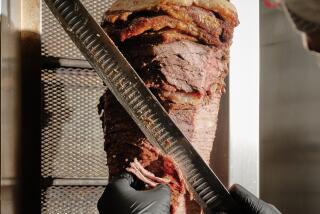Walk a Mile for a Camel? Not When <i> Shishas</i> Are Hot
- Share via
CAIRO — From five-star hotel terraces to alley cafes, many of Cairo’s legions of smokers are dropping Western-introduced cigarettes and returning to the traditional water pipe--but for very different reasons.
“It’s fantasy,” said Ibrahim Shahin, manager of a chic waterfront restaurant at the Gezira Sheraton Hotel where a meal can cost $33, as much as some civil servants earn in a month.
“We’ve always had shisha (water pipes), but it’s become the fashion in the past two years. Everyone wants to be traditional,” he said.
On the terrace, Abdel-Salam Youssef al-Shamy, an industrialist, puffed contemplatively on a pipe and gazed at floodlighted fountains in the middle of the Nile.
“It’s according to our custom,” he said. “That’s how merchants learned what was going on in the souk (market). They sat down with a shisha and tea, inquired after each other’s health, how much the price of gold was, how much silver.”
He tipped the coal-boy, who deftly packs hot embers on the bulb of the pipe, $1.50.
Many of Cairo’s more expensive restaurants and cafes now offer water pipes to the city’s smart set, along with mint tea and traditional Arab delicacies.
In the city center, the trend may be the same but the rationale is different.
“It’s cheaper because I smoke less,” said Mahmoud Hassan, 38, squatting in front of his shanty. “A box of shisha tobacco costs me 35 piastres (10 cents) and lasts two or three days. If I have a packet of cigarettes in my pocket, it’s gone that day.”
Prices for imported Western cigarettes have risen about 70% in the last three years, to more than a dollar per pack of 20. Local brands are no longer considered cheap by ordinary Egyptians at 40 cents.
As in other developing countries, Egyptian smokers are increasingly aware of the health risks, and surveys indicate that tobacco use is declining.
But the habit is still much more prevalent than in the more health-conscious West. Workers smoke in offices, banks, restaurant kitchens--and even when riding their bicycles in the city’s chaotic traffic.
Shisha water pipes, sometimes called narguilas or Hubble-Bubbles, work in much the same way as Western tobacco pipes. By sucking on a wooden mouthpiece to a snake-like tube often three feet long, the smoker draws tobacco burned by live coals down from a bulb through a decorated bottle full of water and into his mouth.
Shisha fans consider the elaborate preparation and total attention required part of its relaxing effect. Shisha , they say, is for contemplation, not stimulation.
“If I smoke one cigarette my head’s destroyed,” said a pipe smoker as he played cards in a street alley cafe. “The shisha is calming.”
But shisha ‘s rich and poor adherents, whether drawn by tradition or pushed by their pockets, are deluded if they think the traditional Arab method of smoking is healthier, a chest disease specialist warned.
“A lot of people have shifted to this method of smoking, but the risks are not lighter; they’re different,” said Dr. Sherif Omar, consultant to the World Health Organization and a leading anti-smoking campaigner.
“The filter provided by the water is not complete, and shared pipes may spread tuberculosis,” Omar said. “Also, the water pipe requires stronger breathing, which can lead to emphysema.”
More to Read
Sign up for Essential California
The most important California stories and recommendations in your inbox every morning.
You may occasionally receive promotional content from the Los Angeles Times.













